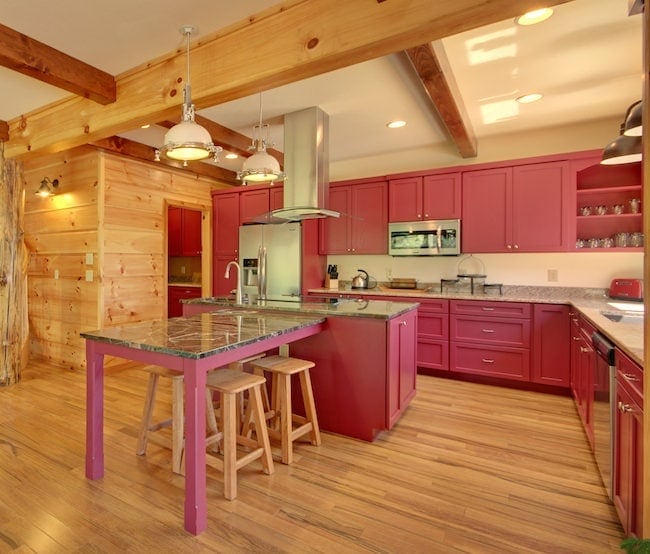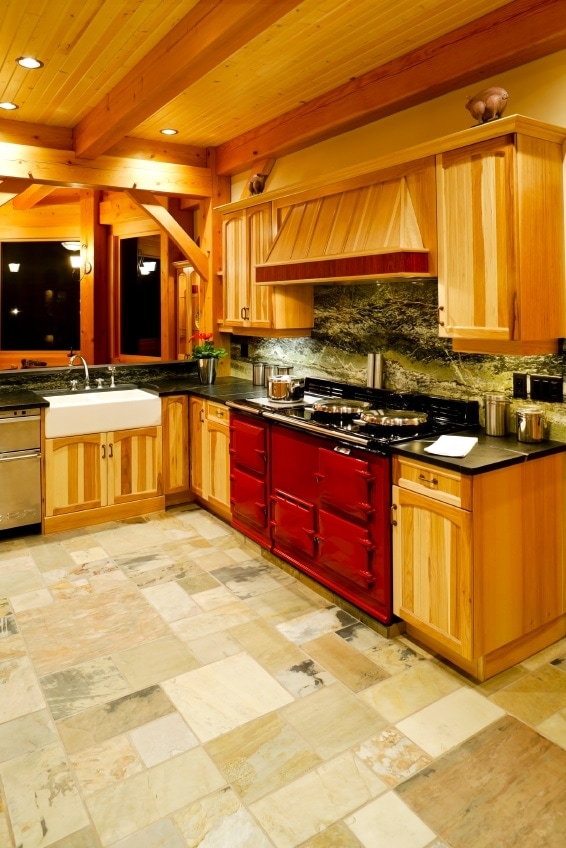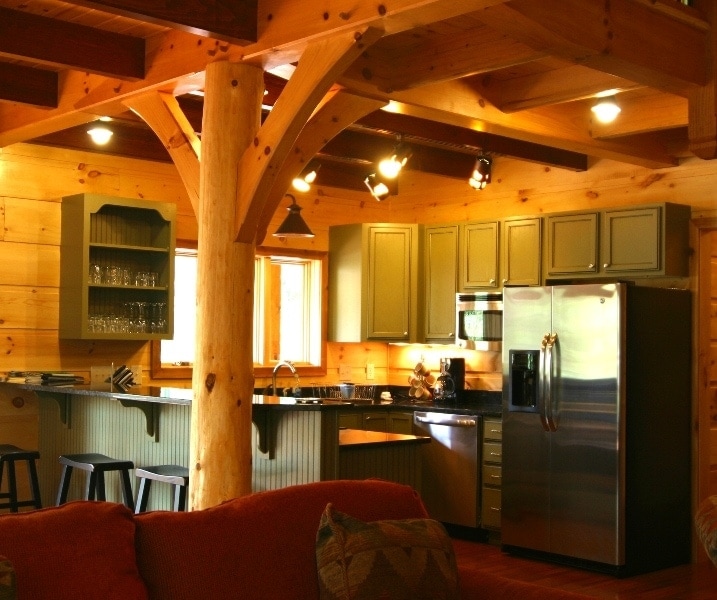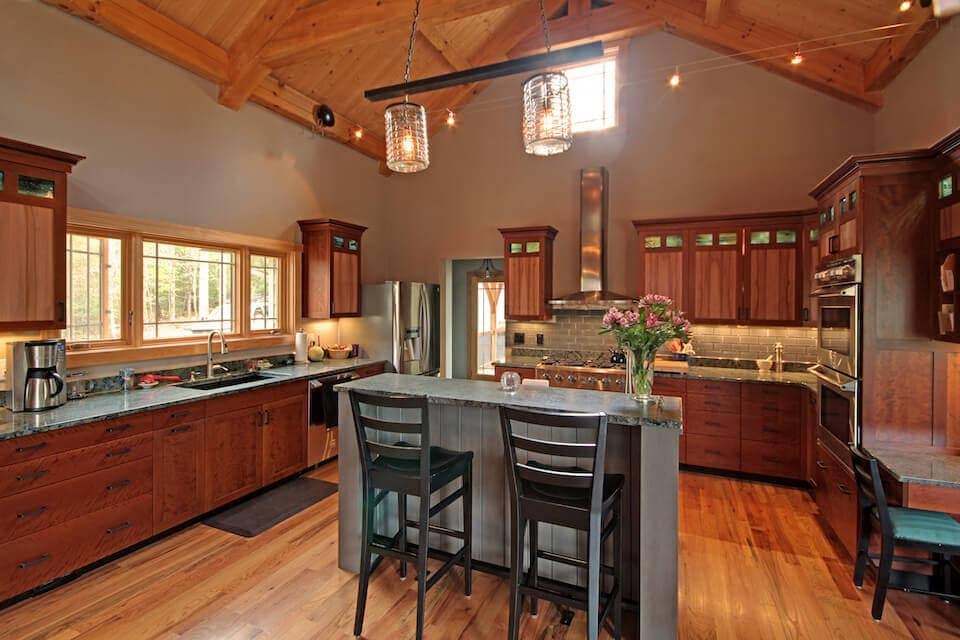The kitchen is the heart of any home. It’s a room that everyone uses, the place where the family gathers, and one of the most functional rooms in any home. Building a functional timber frame kitchen is one of the most important parts of the construction process and one that requires a lot of planning and thought to get right.
However, before you can think about adding appliances, sinks, table, chairs, or even a coffee maker, you have to figure out how to design the space to best serve you and your family. While there are a lot of decisions to be made, they all start with a few basic parts of the kitchen. Here are four of the main things to consider when designing your timber frame kitchen.
1. Shape and Size
The layout (shape) and size of your kitchen will have a great deal of impact on its functionality. Before you try to make these decisions, ask yourself what activities will happen in the kitchen, and how many people will be using the kitchen at the same time. Your lifestyle will play a big part in determining what size and shape is right for you.
Kitchen Layouts:
The five basic kitchen shapes are these:
- Single Wall - very space-efficient; primarily for a studio style apartment.
- Galley - two parallel walls; takes up little space, efficient for a single cook.
- L-Shaped - cabinets run on two adjacent walls; this opens the kitchen to the rest of the home.
- U-Shaped- cabinets are along three walls with an opening on one side. Allows for a great deal of cabinetry and counter space.
- Island - an island can be incorporated into the other kitchen shapes. The island is the hub of activity and defines the space.
Kitchen Size:
The kitchen work triangle is an indicator of the size and functionality of a kitchen. The three major appliances are the the cook top, the sink and the refrigerator, and the distance between the centers of these make up the work triangle. If these appliances are in a comfortable proximity to each other, the kitchen will function smoothly and without a lot of wasted steps. Even in the case of a single-wall kitchen where there will be no actual triangle, the measurements between these three are important. For a functional work triangle, here are some general rules:
- Each leg of the triangle should be between 4 feet and 9 feet .
- When the measurements of all three sides of the triangle are added together, the total should be between 13 feet and 26 feet . (The larger the home, as a rule, the larger the triangle).
- Try to avoid any major traffic flow through the triangle.
There are many other rules of thumb for planning an efficient kitchen, but considering size and shape is a great place to start.

2. Cabinets and Storage
Cabinets and storage are one of the most essential parts of any kitchen. Unfortunately, they’re also one of the most expensive though there are a lot of options out there that can help you stretch your budget.
First, decide what kind of cabinetry you want. There are a lot of different options to choose from and you should find one that suits the atmosphere you’re trying to create.
If cost is a major concern, one alternative is open shelving. Not only does it cost significantly less than traditional cabinetry, but it’s also one of the most popular trends in kitchens. All you have to do is decide where you want the shelving. Usually, long shelves are placed above counters and replace upper cabinets but you can design them for what fits your home best.
Another thing you can do to cut down on cost is to use fewer cabinets. Instead of having them stretch the whole length of the kitchen, have two or three installed that you can use for storing cookware, plates, mugs, pots, and pans. For additional space, invest in building a large pantry where you can store bulk items and staples like bread and cereal. A pantry like this is much less expensive than a long stretch of cabinetry and it holds more food, too.
3. Flooring
The only flooring option that doesn’t work well in a kitchen is carpet because it’s next to impossible to keep clean in a room where you’re cooking and eating food. Tile is a great option because there are so many different kinds to choose from. Porcelain tile is a great choice because it’s often sealed which makes it really easy to clean up spills.
Another great option is vinyl. It’s waterproof, stain proof, and comes in a wide range of styles including some that mimic higher-end flooring like stone or tile. Vinyl is also a little soft which provides some cushioning for long hours on your feet prepping food and cleaning up.

Hardwood flooring is always an option, too, and works particularly well with open floor plans because it transitions well from the kitchen to the dining area and living room. Real hardwood is available but there are also many varieties of engineered planks. These planks consist of a veneer of real wood on the top with a thicker layer of plywood underneath. This allows the wood to be installed on top of a concrete slab as well as a wood subfloor. Often the factory finish protects the wood from moisture which makes it a perfect choice for a kitchen.
There are some other less common options available, too. Cork is a really good option because it’s waterproof and has a bit of softness to it so it’s comfortable when you’re spending a lot of time on your feet. Plus, it also provides some slip resistance which makes your floors just a little bit safer. It’s available in square tiles as well as long planks so you can vary the look using different shapes and patterns. Keep in mind that cork needs to be resealed every few years in order to protect it from damage.
One more option is linoleum. Linoleum has had a bit of a comeback because it’s durable and eco-friendly plus it’s available in a wide range of colors and patterns. This is a very resilient material that resists moisture but can stain so make sure you seal it or use one that has a protective coating.

4. Countertops
There are a few choices when it comes to countertops. Quartz countertops are one of the most popular options. They’re made from natural quartz that has been ground and blended with polymers, resins, and pigments. The surface is very hard and the finish depends on how coarsely the quartz was ground and what materials were blended with it. It’s a little on the expensive side but is really hard and can handle just about anything, including heat.
Another option is laminate. Laminate is by far the least expensive option. Also, forget any of the bad things you may have heard about laminate in the past. Modern laminate has come a long way in how it looks and what it can do. It's made of multiple layers of plastic and particleboard that have been bonded together and can be is available in different colors, textures, and patterns. There are even some options available that mimic some more popular (and more expensive) materials like stainless steel and even marble.
The Big Three
Obviously, there are a lot of other things to consider when building a functional kitchen other than what we’ve mentioned here but these are the big three things that lay the groundwork for everything else. By choosing the right combination of cabinetry, counter tops, and flooring, you not only set the mood for the room but you also make sure that underneath it all, you have what you need in place for your kitchen to function appropriately.
What’s so great about starting with these three things is that you really begin to set the tone for the room. You can stick with the rustic, natural feel that a timber frame home creates or go in a completely different direction to truly make your kitchen yours.

